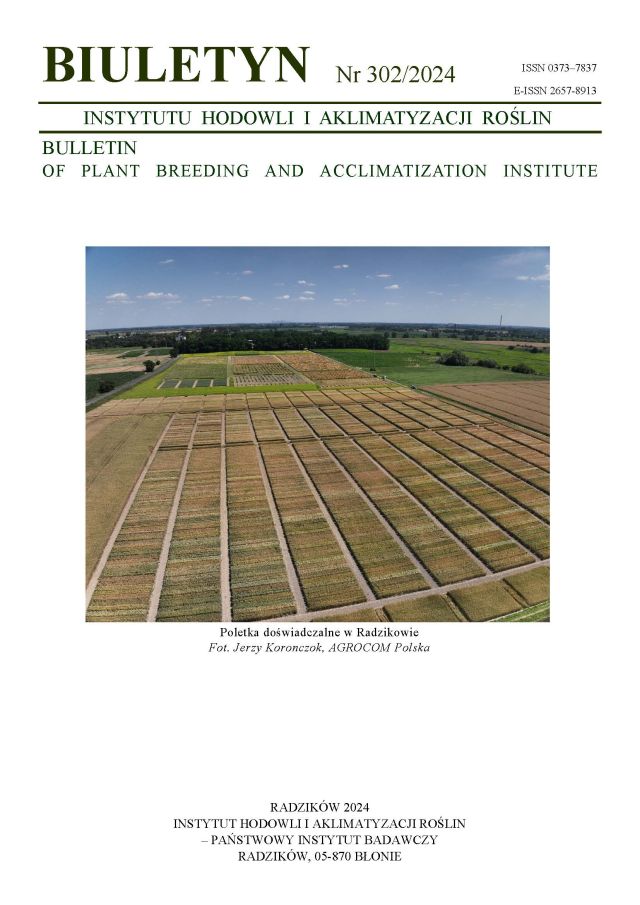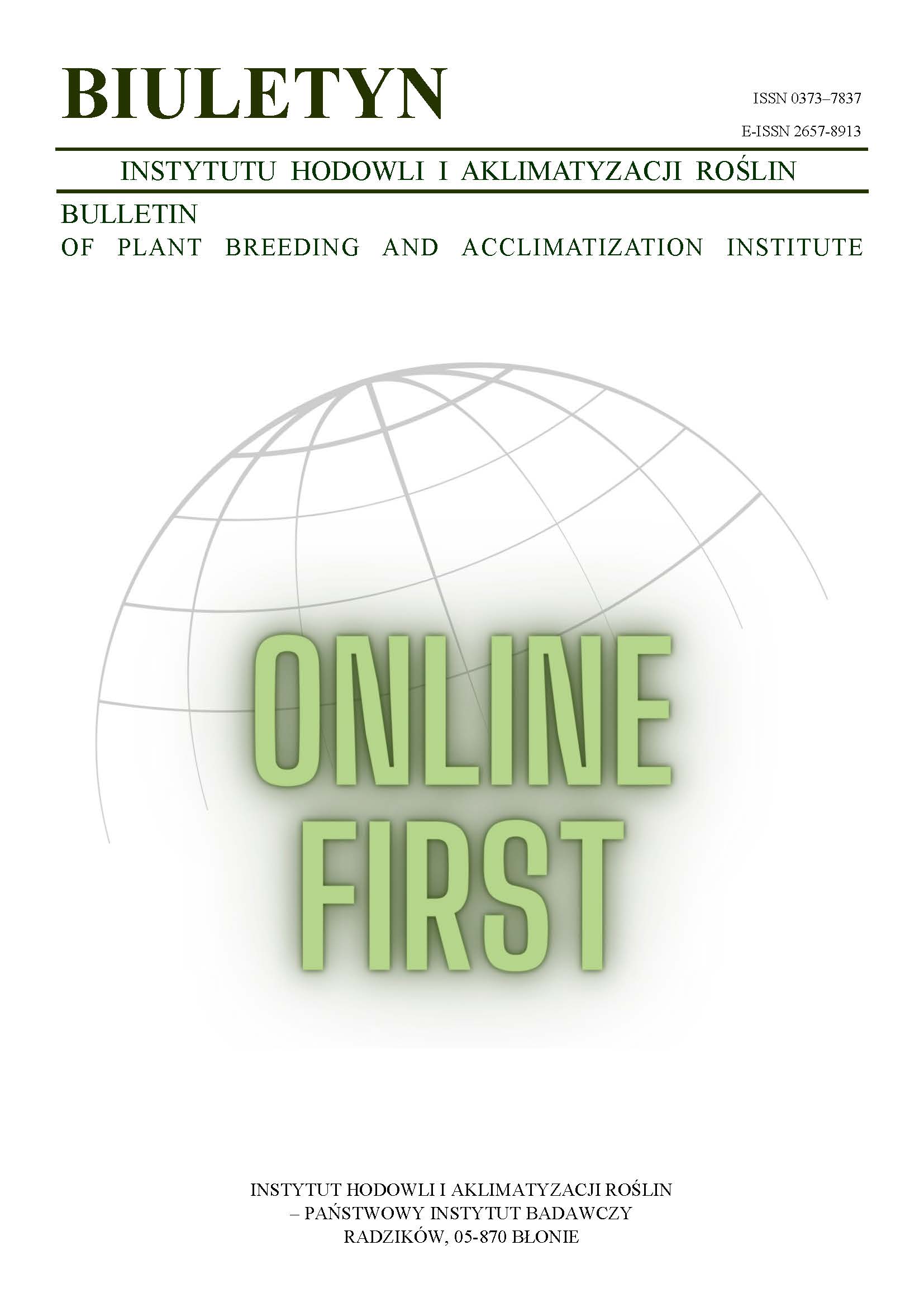The effect of forecrops on biomass of oats in traditional and reduced tillage system
Władysław Nowak
iaipr@upwr.edu.plKatedra Szczegółowej Uprawy Roślin, Akademia Rolnicza we Wrocławiu (Poland)
Józef Sowiński
Katedra Szczegółowej Uprawy Roślin, Akademia Rolnicza we Wrocławiu (Poland)
Abstract
In the first series of the studies conducted in 2003–2004 at the Research Station Pawłowice, belonging to Wrocław Agricultural University, the dry matter yield of Persian clover (Trifolium resupinatum L.) and Westervold ryegrass (Lolium multiflorum var. wersterwoldicum Wittm.) sown as pure stand and in mixture, as well as That of a mixture pea + spring triticale was evaluated. Different levels of nitrogen fertilization were applied. In 2004–2005, the residual effects of the above factors on yielding of oats grown in traditional and reduced tillage systems were examined. Oat plants were cut the at milk-dough maturity to make silage or be fed to animals directly. In the reduced tillage system, the plough was replaced with a cultivator. The elimination of ploughing made the growth conditions at the beginning of vegetation worse, and a number of plants on 1 m2 was smaller by 44%, as compared to that following the full tillage. Similar differences were found in the yield of dry matter of oats, which decreased from over 1100 g (traditional tillage) to 639 g/1 m2 (reduced tillage). After Persian clover sown as pure stand, as well as after pea-triticale mixture, the plant density was higher. In the plot where Persian clover in pure stand was applied, the conditions were favorable throughout the vegetation period and the yield of dry matter of oats was higher by 21–26% than in the plots where the other fore crops were used.
Keywords:
dry matter yield, forecrops, nitrogen fertilization, oats, tillage systemReferences
Adamiak J., Adamiak E., Zawiślak K. 1999. Plonotwórcza i plonochronna rola owsa w płodozmianach zbożowych. Pam. Puł. 114: 15 — 21.
Google Scholar
Adamiak J., Adamiak E., Balicki T. 2005. Wpływ wieloletniej monokultury na występowanie chorób podstawy źdźbła w czterech zbożach. Fragm. Agron. 2 (86): 7 — 13.
Google Scholar
Bartnikowska E., Lange E., Rakowska M. 2000. Ziarno owsa — niedocenione źródło składników odżywczych i biologicznie czynnych. Cz. I. Ogólna charakterystyka owsa. Białka, tłuszcze. Biul. IHAR 215: 209 — 221.
Google Scholar
Bolsen, K. K., Bonilla, D. R., Huck, G. L., Young, M. A., Hart-Thakur, R. A. 1996. Effect of a propionic acid bacterial inoculant on fermentation and aerobic stability of whole-crop maize silage. Proc. XIth Int. Silage Conf. Aberystwyth, UK: 154 — 155.
DOI: https://doi.org/10.4148/2378-5977.2008
Google Scholar
Birkas M., Gyuricza C., Percze A., Ujj A. 2003. Soil conservation and sustainable land management in Hungary. Proceedings of Scientific Conference with International Participation “Sustainable agriculture and rural development” Nitra 25–26 September 2003: 8 — 12.
Google Scholar
Bojarczuk J., Bojarczuk M. 1992. Reakcja owsa na niekorzystne warunki fitosanitarne po różnych przedplonach. Biul. IHAR 181–182: 119 — 127.
Google Scholar
Bräutigam V., Tebrügge F. 1997. Influence of long-termed no-tillage on soil borne plant pathogens and on weeds. Experience with the applicability of no-tillage crop production in the West-European countries. Proceedings of the EC-Workshop-III: 17 — 29.
Google Scholar
Bruckner P. L., Barnett R. D., Johnson J. W., Cunfer B. M. 1991. Registration of “Sunland” triticale. Crop-Science. vol. 31 (6): 1710 — 1711.
DOI: https://doi.org/10.2135/cropsci1991.0011183X003100060087x
Google Scholar
Budzyński W., Fedejko B., Szemplinski W., Majewska K. 1995. Energetyczna, produkcyjna oraz jakościowa ocena różnych technologii uprawy ozimej pszenicy chlebowej. Fragm. Agron. 3: 33 — 52.
Google Scholar
Dzienia S. 1995. Siew bezpośredni technologia alternatywna. Mat. Konf. Nauk. „Siew bezpośredni w teorii i w praktyce. Szczecin Barzkowice 12 czerwca 1995: 9 — 19.
Google Scholar
Dzienia S, Dojss D. 1999. Wpływ sposobów uprawy roli na zachwaszczenie i plonowanie pszenicy ozimej. Fol. Univ. Agric. Stetin. 195, Agricult. 74: 185 — 190.
Google Scholar
Filya I. 2003. Nutritive value of whole crop wheat silage harvested at three stages of maturity. Animal Feed Science and Technology 103: 85 — 95.
DOI: https://doi.org/10.1016/S0377-8401(02)00284-5
Google Scholar
Garcia del Moral L. F. 1992. Leaf area, grain yield and yield components following forage removal in triticale. Journal Agronomy and Crop Science 168: 100 — 107.
DOI: https://doi.org/10.1111/j.1439-037X.1992.tb00985.x
Google Scholar
Grzebisz W. 1989. Growth of crop plants roots in a compacted soil. Fragm. Agron. 3: 19 — 31.
Google Scholar
Hoyt G. D., Monks D. W., Monaco T. J. 1994. Conservation tillage for vegetable production. HortTechnology. 4 (2): 129 — 134.
DOI: https://doi.org/10.21273/HORTTECH.4.2.129
Google Scholar
Kordas L. 1999. Wpływ stosowanego siewu bezpośredniego na nakłady energetyczne i plonowanie pszenicy ozimej. Zesz. Nauk. AR Wrocław. 74: 135 — 139.
Google Scholar
Kuś J. 1995. Rola zmianowania roślin we współczesnym rolnictwie. IUNG Puławy: 35 ss.
Google Scholar
Malicki L., Nowicki J., Szwejkowski Z. 1997. Soil land crop response to soil tillage systems: a Polish Perspective. Soil & Tillage Research 43: 65 — 80.
DOI: https://doi.org/10.1016/S0167-1987(97)00035-4
Google Scholar
Panek K. 1992. Działanie i współdziałanie opadów na plonowanie owsa w różnych rejonach kraju. Biul. Inf. ATR Olsztyn, 33: 95 — 104.
Google Scholar
Pudełko J., Wright D. L. Wiatrak P. 1994. Stosowanie ograniczeń w uprawie roli w Stanach Zjednoczonych. Post. Nauk. Rol. 1: 153 — 162.
Google Scholar
Royo C. E. Montesinos J. L. Molina C. Serra J. 1993. Triticale and other small grain cereals for forage and grain in Mediterranean conditions. Grass for Science 48: 11 — 17.
DOI: https://doi.org/10.1111/j.1365-2494.1993.tb01831.x
Google Scholar
Rudnicki F. 1995. Porównanie reakcji jęczmienia jarego i owsa na warunki opadowo-termiczne. Fragm. Agron. 3 (47): 21 — 32.
Google Scholar
Rudnicki F. 2005. Przedplony zbóż a ich plonowanie w warunkach produkcyjnych. Fragm. Agron. 2 (86): 172 — 182.
Google Scholar
Smagacz J. 1994. Porównanie wydajności zbóż jarych po różnych przedplonach. Fragm. Agron. 3 (43): 35 — 39.
Google Scholar
Sojka R. E., Horne D. J., Ross C. W., Baker C. J. 1997. Subsoiling and surface tillage effects on soil physical properties and forage oat stand and yield. Soil & Tillage Research. 40: 125 — 144.
DOI: https://doi.org/10.1016/S0167-1987(96)01075-6
Google Scholar
Sowiński J. 2004. Wpływ sposobu uprawy i nawożenia azotem na plonowanie pszenicy ozimej przeznaczonej na kiszonkę i ziarno. Zesz. Nauk. AR we Wrocławiu, nr 490, Rozprawy CCXVI: 107 ss.
Google Scholar
Twidwell E. K., Johnson K. D., Cherney J. H., Ohm H. W. 1987. Forage yield and quality of soft red winter wheat and a winter triticale. Applied Agricultural Research. 2 (2): 84 — 88.
Google Scholar
Wasilewski W. 1997. Produkcja pasz w uprawie polowej. http://www.ostw.pl/pliki_do_pobrania/-Produkcja%20pasz%20w%20uprawie%20polowej.doc.
Google Scholar
Wilkins R. J., Kirilov A. P. 2003. Role of forage crops in animal production systems. Grassland Science in Europe 8: 283 — 291.
Google Scholar
Wróbel E. 1993. Wpływ nawożenia azotem na plonowanie i jakość białka jęczmienia jarego i owsa uprawianego na paszę. Acta Acad. Agricult. Tech. Olst., Agricultura 56: 3 — 52.
Google Scholar
Authors
Władysław Nowakiaipr@upwr.edu.pl
Katedra Szczegółowej Uprawy Roślin, Akademia Rolnicza we Wrocławiu Poland
Authors
Józef SowińskiKatedra Szczegółowej Uprawy Roślin, Akademia Rolnicza we Wrocławiu Poland
Statistics
Abstract views: 73PDF downloads: 26
License
Copyright (c) 2006 Władysław Nowak, Józef Sowiński

This work is licensed under a Creative Commons Attribution-ShareAlike 4.0 International License.
Upon submitting the article, the Authors grant the Publisher a non-exclusive and free license to use the article for an indefinite period of time throughout the world in the following fields of use:
- Production and reproduction of copies of the article using a specific technique, including printing and digital technology.
- Placing on the market, lending or renting the original or copies of the article.
- Public performance, exhibition, display, reproduction, broadcasting and re-broadcasting, as well as making the article publicly available in such a way that everyone can access it at a place and time of their choice.
- Including the article in a collective work.
- Uploading an article in electronic form to electronic platforms or otherwise introducing an article in electronic form to the Internet or other network.
- Dissemination of the article in electronic form on the Internet or other network, in collective work as well as independently.
- Making the article available in an electronic version in such a way that everyone can access it at a place and time of their choice, in particular via the Internet.
Authors by sending a request for publication:
- They consent to the publication of the article in the journal,
- They agree to give the publication a DOI (Digital Object Identifier),
- They undertake to comply with the publishing house's code of ethics in accordance with the guidelines of the Committee on Publication Ethics (COPE), (http://ihar.edu.pl/biblioteka_i_wydawnictwa.php),
- They consent to the articles being made available in electronic form under the CC BY-SA 4.0 license, in open access,
- They agree to send article metadata to commercial and non-commercial journal indexing databases.
Most read articles by the same author(s)
- Tomasz Zbroszczyk, Władysław Nowak, Effect of the protection level and nitrogen fertilization on yielding and chemical composition of the grain of several varieties of fodder spring barley. Part I. Yielding , Bulletin of Plant Breeding and Acclimatization Institute: No. 251 (2009): Regular issue
- Józef Sowiński, Edward Możdżeń, The influence of sampling time of fodder galega (Galega orientalis Lam.) on seed yield and the effect of scarification method on seed quality , Bulletin of Plant Breeding and Acclimatization Institute: No. 246 (2007): Regular issue
- Tomasz Zbroszczyk, Władysław Nowak, Effect of the protection level and nitrogen fertilization on yielding and chemical composition of the grain of several varieties of fodder spring barley. Part II. Chemical composition , Bulletin of Plant Breeding and Acclimatization Institute: No. 251 (2009): Regular issue














